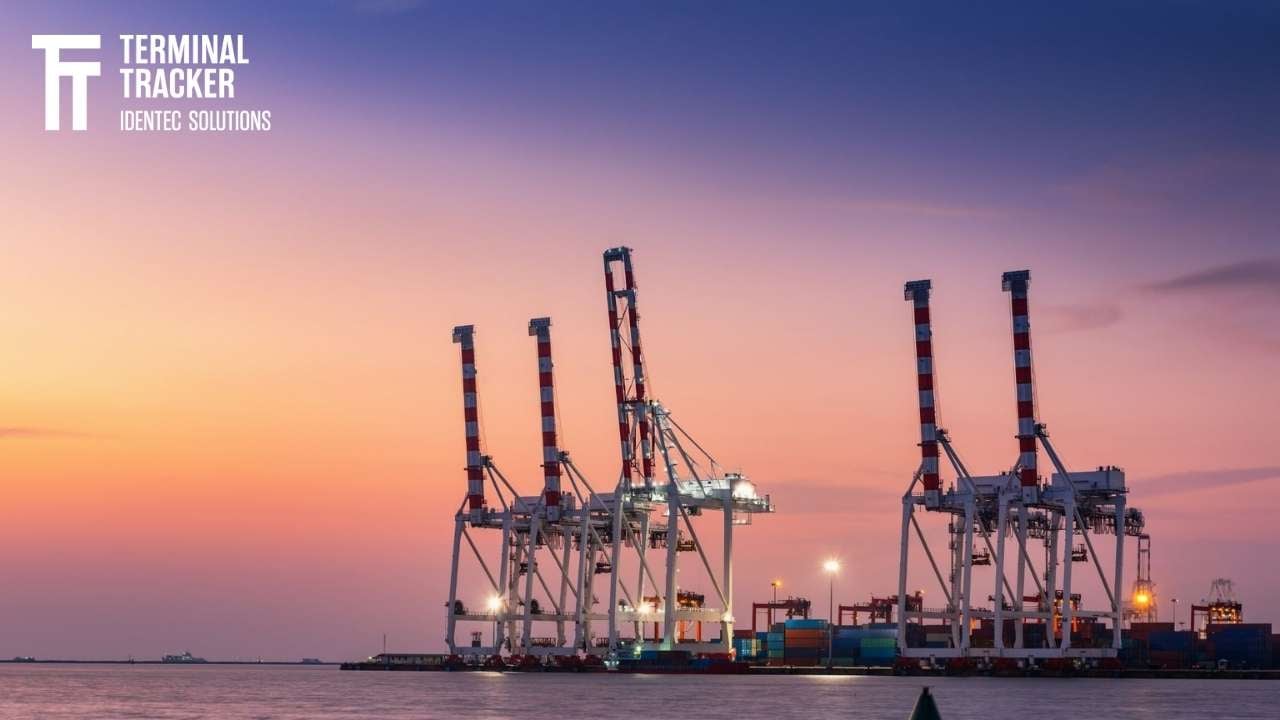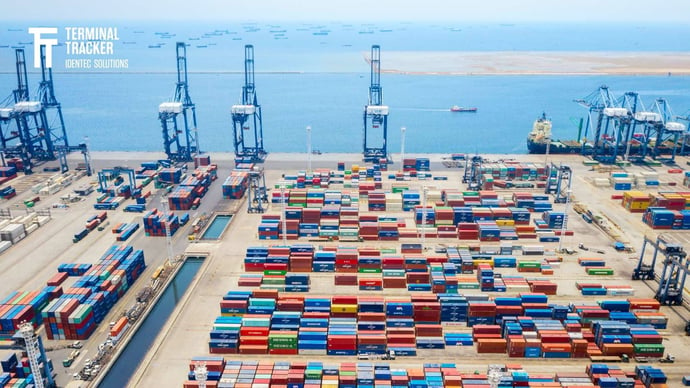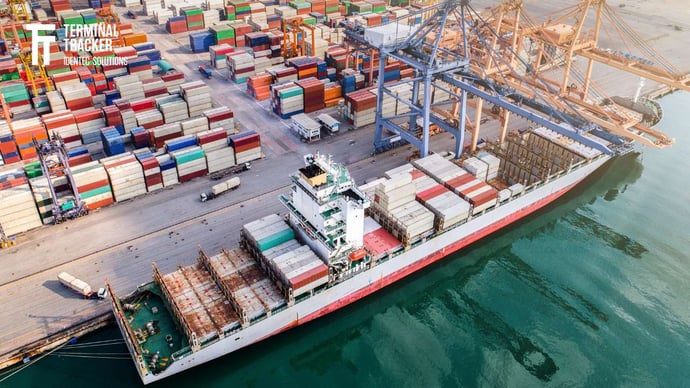How to calculate berth productivity?
| Written by Mark Buzinkay

No video selected
Select a video type in the sidebar.
"Leveraging real-time data analytics empowers terminal operators to make swift, informed decisions, significantly enhancing berth productivity and operational efficiency."
Paul Hebrard, Regional Head Asia & Pacific
Why Does BERTH PRODUCTIVITY MATTER?
Ships are getting bigger and bigger. Today's most powerful vessels can carry 25.000 TEU and more. This accelerating development is triggered to reduce operating costs: more containers per trip means higher profitability.
On the other side, this trend puts pressure on terminals to perform because shipping lines need to stay on schedule to meet their customer's demands. Demurrage costs can decrease profits, and higher fuel consumption when catching-up lost time annihilates the rest.
The consequences of being late are likely to escalate because, as mega-ships take up more time at port, berth windows are harder to find, putting the already late vessel even further off its planned arrival.
One strategy to cope with mega-vessels' appearance and decreasing schedule reliability is to improve productivity per berth and, eventually, your port terminal operations.
Historical Insight
The concept of berth productivity has been around for centuries. In its simplest form, berth productivity is a measurement of how much cargo is moved through a given berth in a certain amount of time. This measurement can be used to assess overall efficiency in ports and container terminals. The concept dates back to the 1700s when the British developed the principle of “berth productivity” to measure and optimize the speed with which ships were loaded and unloaded at the ports.
In the early days, berth productivity was calculated manually. Ships would be surveyed, and the number of containers, length of time, and labour would be used to calculate productivity. This data was then used to determine the efficiency of the port operations. However, this process was slow and labour-intensive, and it was difficult to track the information accurately.
The advent of technology in the late 19th century revolutionized the concept of berth productivity. Automated systems such as electric cranes and forklifts were introduced and allowed for faster loading and unloading of ships, thereby increasing berth productivity. Furthermore, the use of modern telecommunication technologies enabled port authorities to collect and analyze data more efficiently. This allowed for more accurate measures of berth productivity and the ability to identify areas for improvement.
By the mid-20th century, the concept of berth productivity had evolved significantly. Improved technologies had allowed ports to become more efficient, and measuring berth productivity had become commonplace. By the end of the century, computer systems had become ubiquitous, providing port authorities with more detailed data and an ability to identify areas of improvement more quickly.
Today, berth productivity is still measured using manual and automated systems. However, the use of modern technology has enabled ports to measure and improve berth productivity more effectively. Advanced technologies such as IoT (Internet of Things) sensors, automated systems, and Artificial Intelligence (AI) have enabled ports to optimize their systems for increased productivity. Furthermore, the use of data analytics has allowed port authorities to gain deeper insights into their operations, enabling them to identify and address areas of improvement more quickly.
Current Challenges
The challenges posed by current conditions on berth productivity have become increasingly complex over time. From weather conditions like stormy seas or fog to changing traffic patterns and global trade, container terminals must find ways to achieve optimal productivity.
Weather conditions are an especially important factor in berth productivity. From seasonal unknowns like monsoons to the day-to-day variations in wind and wave patterns, container terminals must account for the effects of weather on their operations. Delays due to weather can lead to costly backlogs, disrupting the flow of goods and services.
Ports that operate closer to 24/7 schedules, such as Hong Kong and Dubai, tend to have higher berth productivity numbers due to handling large container volumes with minimal downtime. (1) The changing traffic patterns of the modern age have also caused major challenges for container terminals. With the rise of international trade, cargo ships have become larger and more frequent, leading to increased competition for dock space. This influx of new ships has caused congestion and delays that can greatly affect berth productivity.
Global trade and travel have also drastically changed the landscape of the shipping industry. As trade expands, so too do the distances that goods must travel. This has resulted in longer wait times as ships traverse the globe, creating increased pressure on container terminals to work more efficiently.
The challenges of modern container terminals are numerous and require an agile and strategic approach to ensure berth productivity remains strong in today's ever-changing environment.
Learn more about predictive planning in ports.

HOW is BERTH PRODUCTIVITY Calculated?
Berth productivity is the average number of container moves per crane per hour while a ship is at berth. High berth productivity means that many containers have been moved per crane per hour. It does not say how many cranes have been in operation, how much workforce has been used and which other factors (RTGs, available space, ...) have played a role. Nevertheless, it is an essential key indicator to measure the overall performance of a terminal and how it handles a ship at berth. It measures efficiency and is part of a set of performance indicators in the port: berthing capacity, storing capacity, loading/unloading equipment, floor size, and the number of gate lanes are other vital indicators.
Learn more about Ports and Position Detection System
Considering the total input and output of handling vessels, you look at port productivity. The top-performing terminals in the world are in East Asia. There are several reasons for this, but the massive usage of a maximum amount of cranes per ship increases the total moves per hour to 180 or more. But there is a limit: a maximum of eight cranes can work the largest ships simultaneously. So, the only way to increase the total number of moves and, therefore, decrease the number of hours at berth is to raise crane productivity.
Strategies to Increase Berth Productivity
As changes in technology, global trade and travel, and weather conditions continue to challenge the calculation of berth productivity, it is important for terminals to adopt strategies to increase their berth productivity. Utilizing advanced technology, streamlining cargo handling processes, and task specialization for labourers are a few of the key strategies that can help terminals boost their berth productivity.
Utilizing advanced technology is one of the most effective strategies for increasing berth productivity. By incorporating the latest technologies, terminals can optimize the efficiency of their operations, ensuring that the berths are productive and running smoothly. Technologies such as automated container handling systems, automated stacking cranes, automated guided vehicles, and RFID systems are just a few of the technologies that terminals can use to improve their berth productivity.
Crane productivity, hence the average number of moves per crane, depends not only on the speed of the crane operator but there are obstacles as well: the space below the crane and the way containers are moved between yard stacks and quays. Container congestion is the thing to fix. The more boxes are moved on or off a vessel, the more vehicles are needed.
The first step to improving crane productivity is looking at the right indicators. After that, what gets measured gets done. But do we measure the right indicators? Process engineering is the basis of what is called process optimization. Every step must be looked at and evaluated before we can get to a thorough understanding of a complex process landscape.
In addition to utilizing advanced technologies, terminals can streamline their cargo handling processes to increase berth productivity. By streamlining the processes, terminals can ensure that cargo is handled efficiently and quickly so that ships can be loaded and unloaded quickly and safely. Streamlining processes such as loading and unloading, documentation, and inventory management can help to improve berth productivity.
Task specialization for labourers is another effective strategy for increasing berth productivity. By assigning specific tasks to each labourer, terminals can ensure that the labour force is used efficiently and effectively. This will help to reduce the time it takes to perform each task, which can ultimately help to improve berth productivity.
When it comes to deploying cutting-edge digital applications, the overall container shipping industry's current history has not been one of prompt identification and implementation, according to a World Economic Forum report. Therefore, how effectively advanced digital tools are applied by the world's ports in the future will be a topic of growing importance as those cutting-edge technologies that prove most effective at reducing costs and boosting productivity become the norm increasingly (understand more about port terminal automation here).
These are just a few of the strategies that terminals can use to increase their berth productivity. By utilizing advanced technology (RFID automation), streamlining cargo handling processes, and task specialization for labourers, terminals can ensure that their berths are productive and running smoothly. This will help to ensure that ships can be loaded and unloaded quickly and safely and that berths are able to maximize their efficiency.
FAQ
What is effective time, and what is berthing time?
Effective time is the time a ship spends actively handling cargo. It includes all the time required for loading and unloading, excluding interruptions or unproductive times. Effective time is a valuable metric for determining the efficiency and productivity of ships' loading and unloading processes.
On the other hand, berthing time includes the entire time a ship spends at the berth in the port, from the moment of docking to departure. It includes activities such as cargo operations, refuelling, maintenance, documentation, and other required processes. It provides information about the entire port stay and all productive and unproductive activities.
Comparing these two values makes it possible to identify bottlenecks and optimize processes to reduce idle time and increase productivity. Analysis of vessel waiting time and laytime shows that larger vessels wait longer, so terminals should create differentiated berthing plans based on vessel size and berthing time, for example.
Other parameters that influence the time spent at the port are:
Just like during rush hour on the highway, there are peak times in the port. The more vessels waiting for a berth, the longer the waiting time.
If a vessel misses its slot due to previous delays or delays at sea, it may have to wait quite a while until a new slot can be found.
Of course, the weather can also interfere. Strong winds and currents can make berthing manoeuvres significantly more difficult or even impossible.
Container vessels have rapidly increased in size in recent years. This affects both the space required on the berth and the need for deeper waters for more draft. Not all ports have enough capacity for these mega-ships.
The amount and type of cargo can also affect the time required. If many containers or those with complex cargo, such as dangerous goods, have to be handled, this often requires more time and special handling.
Takeaway
In conclusion, berth productivity is an important aspect of container terminal operations and should be monitored closely. By understanding how to calculate berth productivity and utilizing strategies such as advanced technology, streamlining cargo handling processes, and task-specializing laborers, container terminal operators can increase berth productivity and run a more efficient business. Semi-automation of processes increases the overall crane productivity and helps dramatically improve berth productivity.
If you want to learn more about how to upgrade your running terminal into a semi-automated terminal, continue reading this post about an automation project.
Do you want to learn more about how semi-automation is increasing productivity?
Delve deeper into one of our core topics: Smart Port
Glossary
Demurrage is a charge imposed by shipping lines when containers remain at the port or terminal beyond the allotted free time. It typically applies to full containers that haven't been picked up by the consignee after discharge from the vessel. Demurrage is calculated per container per day, with rates varying by carrier, terminal, and container type. It aims to encourage prompt container retrieval and return, ensuring efficient port operations and equipment turnover. (2)
Mega vessels, also known as Ultra Large Container Vessels (ULCVs), are massive container ships with a capacity exceeding 18,500 TEUs. These ships can measure up to 400 meters in length and 59 meters in width. They are primarily deployed on long-distance routes, such as the Far East to North Europe, due to their size and cargo capacity. Mega vessels offer benefits like increased freight volume and lower fuel costs per container but also pose challenges for port infrastructure and logistics. (3)
Sources:
(1) https://www.joc.com/sites/default/files/u59196/Whitepapers/Port_productivity/portProductivity_whitepaper.pdf
(2) Commercial Management in Shipping by Don L. Dykstra, The Nautical Institute, 2005
(3) Container Logistics: The Role of the Container in the Supply Chain by Rolf Neise, Kogan Page, 2018
Note: This article was updated on the 21st of January 2025

Author
Mark Buzinkay, Head of Marketing
Mark Buzinkay holds a PhD in Virtual Anthropology, a Master in Business Administration (Telecommunications Mgmt), a Master of Science in Information Management and a Master of Arts in History, Sociology and Philosophy. Mark spent most of his professional career developing and creating business ideas - from a marketing, organisational and process point of view. He is fascinated by the digital transformation of industries, especially manufacturing and logistics. Mark writes mainly about Industry 4.0, maritime logistics, process and change management, innovations onshore and offshore, and the digital transformation in general.




